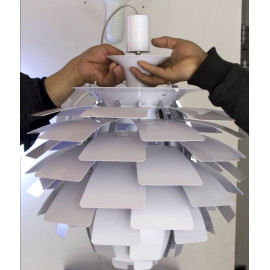Your shopping cart is empty!
Ceiling Lamp Silver - 48cm
The PH lamp is one of the most well known ceiling light designs in the world. It was originally created by famous Danish author, architect, designer. It uses a complex system of leaves to reflect light from a central bulb, which cannot be viewed directly. The light is a flame-free light fixture, which envelops the light source, defl..
Ceiling Lamp Silver - 60cm
The PH lamp is one of the most well known ceiling light designs in the world. It was originally created by famous Danish author, architect, designer. It uses a complex system of leaves to reflect light from a central bulb, which cannot be viewed directly. The light is a flame-free light fixture, which envelops the light source, defl..
Ceiling Lamp WHITE - 48cm
The PH lamp is one of the most well known ceiling light designs in the world. It was originally created by famous Danish author, architect, designer. It uses a complex system of leaves to reflect light from a central bulb, which cannot be viewed directly. The light is a flame-free light fixture, which envelops the light source, defl..
Ceiling Lamp Copper - 48cm
The PH lamp is one of the most well known ceiling light designs in the world. It was originally created by famous Danish author, architect, designer. It uses a complex system of leaves to reflect light from a central bulb, which cannot be viewed directly. The light is a flame-free light fixture, which envelops the light source, deflec..
Ceiling Lamp Copper - 60cm
The PH lamp is one of the most well known ceiling light designs in the world. It was originally created by famous Danish author, architect, designer. It uses a complex system of leaves to reflect light from a central bulb, which cannot be viewed directly. The light is a flame-free light fixture, which envelops the light source, deflect and re..
Ceiling Lamp Gold - 48cm
The artichoke lamp is one of the most well known ceiling light designs in the world. It was originally created by famous Danish author, architect, designer and all round intellectual [designer]Poul Henningsen[/designer]. The artichoke light reproduction is based on the same theme and paul lamp replica uses a complex system of leaves to reflect ..

















